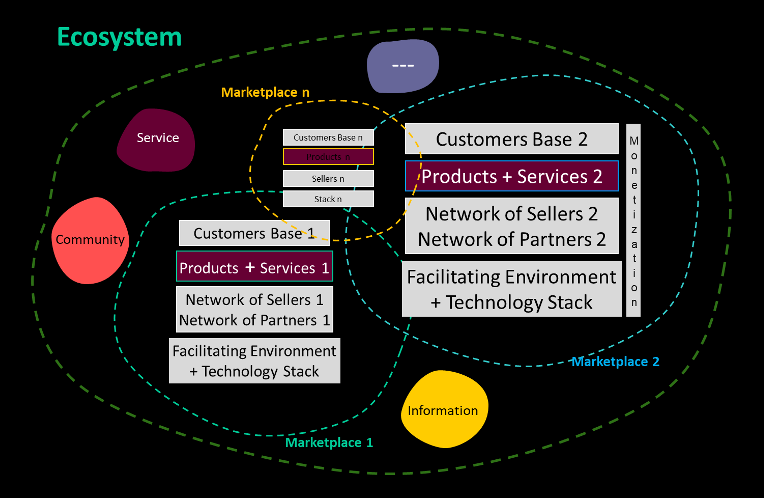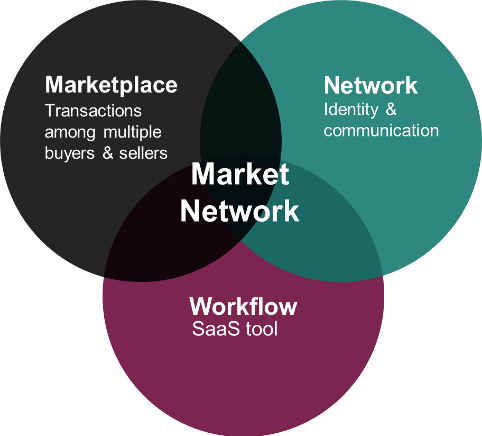
We discuss the following topics in this blog:
- What is a marketplace in general?
- Significance of marketplaces in digital arenas
- Understand Market Networks
In addition to these topics, we shall also be answering the following FAQs:
- What is WiFi?
- What is backhaul?
Contents
Overview
Of late, every discussion includes terms such as Platforms, Markets, Aggregators and Market Networks. These terms are used interchangeably and sometimes used as distinct entities leading to royal confusion. I truly believe that the distinction between knowing something and knowing its name is the distinction between outcomes and optics. As a result, I wanted to get to know them thoroughly so that I could tell them apart and understand the jargon that surrounded them. This blog is an attempt to demystify the terminology.
What is a Marketplace?
Marketplace is pretty simple to understand. Souk, Bazaar or Mandi are all examples of marketplaces for centuries. It is an enclosed or dedicated place where buyers and sellers meet. These are the go-to places in a given town or a city to buy anything you need as there are many sellers and buyers at a given time in a marketplace. And there are marketplaces for a specific category of items such as produce, seafood, agri-tools, or cloth markets, etc.
Similarly, marketplaces exist in the digital arena too. These are the digital twins of physical marketplaces. A marketplace on a digital space (website) curates and sells the products and services of different sellers and partners at a single place. Amazon and Flipkart are now canonical B2C marketplace examples while AWS, ZOHO, Salesforce are B2B marketplaces; And Ethereum, Hyperledger Fabric, Corda are Enterprise Blockchain marketplaces.
By bringing together numerous traders/partners on a single platform, marketplace offers transparency and complies sellers to compete not just on features, price, and service but on customer experiences as well. Then incentive for sellers to join the platform is massive savings on marketing and customer acquisition and a provision to transfer those benefits to their customers.
This creates far more efficient markets where both consumers and vendors would benefit from having more options with better infrastructure and data. The firm/brand only acts as a mediator and doesn’t own the products or services provided. Hence, the prices are largely influenced by the sellers themselves.
Marketplace only charges a commission (% of GMV) as they are providing sellers with a platform (efficient distribution and access to customer base) to sell. Dialog Axiata IdeaBiz is a plain vanilla API marketplace example for Telcos. And if you love marketplaces as we do, relish this killer whitepaper on Telco marketplace we have authored.
As a recap, the defining characteristics of a marketplace
are
1. Various products and services from competing vendors at a single place
2. Secured and personalized customer journey experience right from discovery to
post-delivery
3. Analytics-driven, cloud-native, omnichannel & rich CX
It is important to note that marketplaces are different from Aggregators. The Aggregators own the products and services in terms of branding. For similar categories of products and services, pricing and quality are almost always the same (aggregator determines pricing). Uber is a good example.
How to Understand Market Networks?

Enter Market Networks. This is another term that pops up often. No one in the room gets it but they nod vehemently, apart from the fact it is a hybrid word!
Market Networks combine the strong network effects such as defensibility and scalability of direct networks like LinkedIn or Facebook together with the lucrative revenue models of SaaS or marketplace businesses such as Amazon or Alibaba. Market networks are also unique from a monetization standpoint. These define the market networks:
- Combine the main elements of both networks and marketplaces
- Use SaaS workflow software to focus action around longer-term projects; not just a quick transaction
- Promote the service provider as a differentiated individual to help build long-term relationships
In the last decade, we were obsessed over on-demand labor marketplaces for quick transactions of simple services. Companies like Uber, Mechanical Turk, Upwork or Urbanclap and many others made it efficient to buy simple services whose quality is judged objectively.
Their success was based on commodifying the people on both sides of the marketplace. However, the highest value services like event planning, tech overhaul etc. are neither simple nor objectively judged. They are more involved, complicated and longer-term. As you can realize, there is a massive collaboration among multiple participants on the platform to deliver a service or a project. This is the marked differentiator between marketplace and market network.

Market Network on 2×2 Matrix
Sources:
- Fritjof Capra on Ecosystems: https://www.ecoliteracy.org/article/ecology-and-community
- Non-traditional B2B Platform: https://www.kloecknermetals.com/
- Platforms and Ecosystems: Enabling the Digital Economy (WEF)
- The Next Great Unbundling: https://a16z.com/2019/09/11/platforms-verticals-unbundling/
- Book: Invisible Engines: https://mitpress.mit.edu/books/invisible-engines
- Roadmap: B2B Marketplaces: Bessemer Venture Partners
- What do you mean by Platform: TM Forum Analysis
- Platform Business Model: https://www.applicoinc.com/blog/what-is-a-platform-business-model/
- What I Talk About When I Talk About Platforms: Martin Fowler
FAQs
What is WiFi?
Put simply, WiFi is a technology that uses radio waves to create a wireless network through which devices like mobile phones, computers, printers, etc., connect to the internet. A wireless router is needed to establish a WiFi hotspot that people in its vicinity may use to access internet services. You’re sure to have encountered such a WiFi hotspot in houses, offices, restaurants, etc.
To get a little more technical, WiFi works by enabling a Wireless Local Area Network or WLAN that allows devices connected to it to exchange signals with the internet via a router. The frequencies of these signals are either 2.4 GHz or 5 GHz bandwidths. These frequencies are much higher than those transmitted to or by radios, mobile phones, and televisions since WiFi signals need to carry significantly higher amounts of data. The networking standards are variants of 802.11, of which there are several (802.11a, 802.11b, 801.11g, etc.).
What is backhaul?
Backhaul is a transport network that connects the core network (routes data in various sub-networks) and access network (connects end devices to the network). Backhaul can be wired (via optical fibre cable/copper cable/ coaxial cable/ethernet cable) or wireless (via Free space optics (FSO)/Point to Point microwave radio transmission such as terrestrial or satellite/ Point to Multipoint microwave radio transmission such as LDMS, WiFi, WiMAX). Wireless backhaul offers cost efficiency, ease of deployment and high capacity. On the other hand, Wireline backhaul offers endless capacity, better life span, reliability but require significant investment on the network deployment side.
Use cases of Backhaul:
a) Mobile Backhaul: As more users keep coming online and data-heavy applications increase in number, the global mobile data traffic is going up. This demands broader network coverage and larger capacity/bandwidth. To address these challenges service providers have to either put more macro towers or increase spectrum spaces or develop newer technologies such as LTE/LTE-A to utilise the spectrum more efficiently, all of which is capital intensive. Another inexpensive solution is mobile backhaul which essentially is low powered small towers with lesser footprint for catering to the user and their needs more efficiently. These small cells can be Femto (indoor cell for the residential area; 10m to 1km) / Pico (indoor cell for small businesses; range 200m) / Micro (for rural areas; range 35kms) / Metro (for urban areas; less than 100m) for extending macrocell service.
b) Private Networks: On-premise networks that are owned privately have dramatically enabled organisations to transition from expensive legacy based voice-only networks to media and applications serving networks. With high user density and data demand, wireless backhaul networks like LTE (pico/femto cells) work best for such environments.
c) Critical Infrastructure Networks: Such networks demand communications to be secure and available at all times with ultra-low latency. Existing mission-critical networks like TETRA, Tetrapol, etc. are voice-centric and going forward to serve the needs the future will be around 4G/5G technologies. To deliver high-performing applications like real-time video, high-resolution imagery, multimedia messaging, situational awareness etc. backhaul support will be a must.














1 Comment
STL
November 4, 2020Nice Writeup